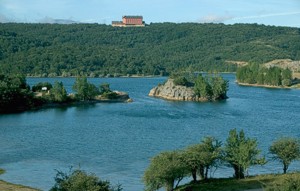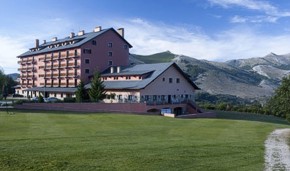
Cervera de Pisuerga, Castile-LeonCervera is a stately town with a rich past located in the province of Palencia in Spain’s northern region of Castile Leon. One of the main tourist centres in the area, it is set in the mountains, surrounded by rivers and valleys, and is particularly popular with those who enjoy hiking and mountain biking. The province is home to one of largest concentrations in Europe of Romanesque architecture, and the medieval village of Cervera de Pisuerga is a fine example. Even the simple country Shrine of San Pelayo, although small in size, has some very unexpected features. For example there is a semi circular aspe built with carved ashlar stones, and a frieze cornice decorated in what is known as the ‘ajedrezado jaques’ design, very similar to a chessboard. Inside there are the only remains in the region of a 12th century Romanesque mural painting. Some of the main places of interest in Cervera is the Plaza Mayor and the Church of Santa Maria del Castillo. This 16th century church is a National Monument with an Hispano-Flemish altarpiece in the chapel, and rather special religious sculptures and paintings. The town has a museum as well, the Ethnographic Museum Isla Piedad, located in a 16th century house, with a collection of everyday objects to take you back in time and show you what life was like in days gone by. Not far from town, on the road leading to the town of Vado de Cervera, is the extraordinary looking Hermitage of San Vicente cave. Dating back to the early Middle Ages, it consists of a large rectangular room with several different entrances, and a small chapel. It is quite a unique site and well worth making the drive to see it. In addition to the number of charming mountain villages in this area, Cervera is also a great starting point for many excursions into the mountains. It is also the main entrance to the National Park of Fuentes Carrionas. If you do decide to go hiking, try to look for the Rivet of Estalaya, the largest oak tree in the mountains. It is 800 years old, stands 12 feet high, and is 10m in diameter. 
The Ruesga Reservoir was built in 1923 to supply the Canal de Castilla. It covers an area of 106 hectares, and is the oldest reservoir in the province. It is also one of the most popular attractions in the area, with pedal boats to rent and a sandy area for swimming. The Parador Cervera De Pisuerga (Hotel Fuentes Carrionas) sits at the foothills of the Picos de Europa, and has breathtaking views of the Ruesga Reservoir. This three star hotel was built in the style of a hunting lodge and serves excellent Castilian cuisine. Because Cervera is so well known for its beef, be sure to sample it while you are there. One of the best times to visit Cervera is in July and August when the town holds four festivals; the San Cristobal, Santa Marta, the Festival of Nuestra Senora and San Roque. But whatever time of year you come, you will always be guaranteed scenery that is as beautiful in the snow as it is during the lush, green summer months. |